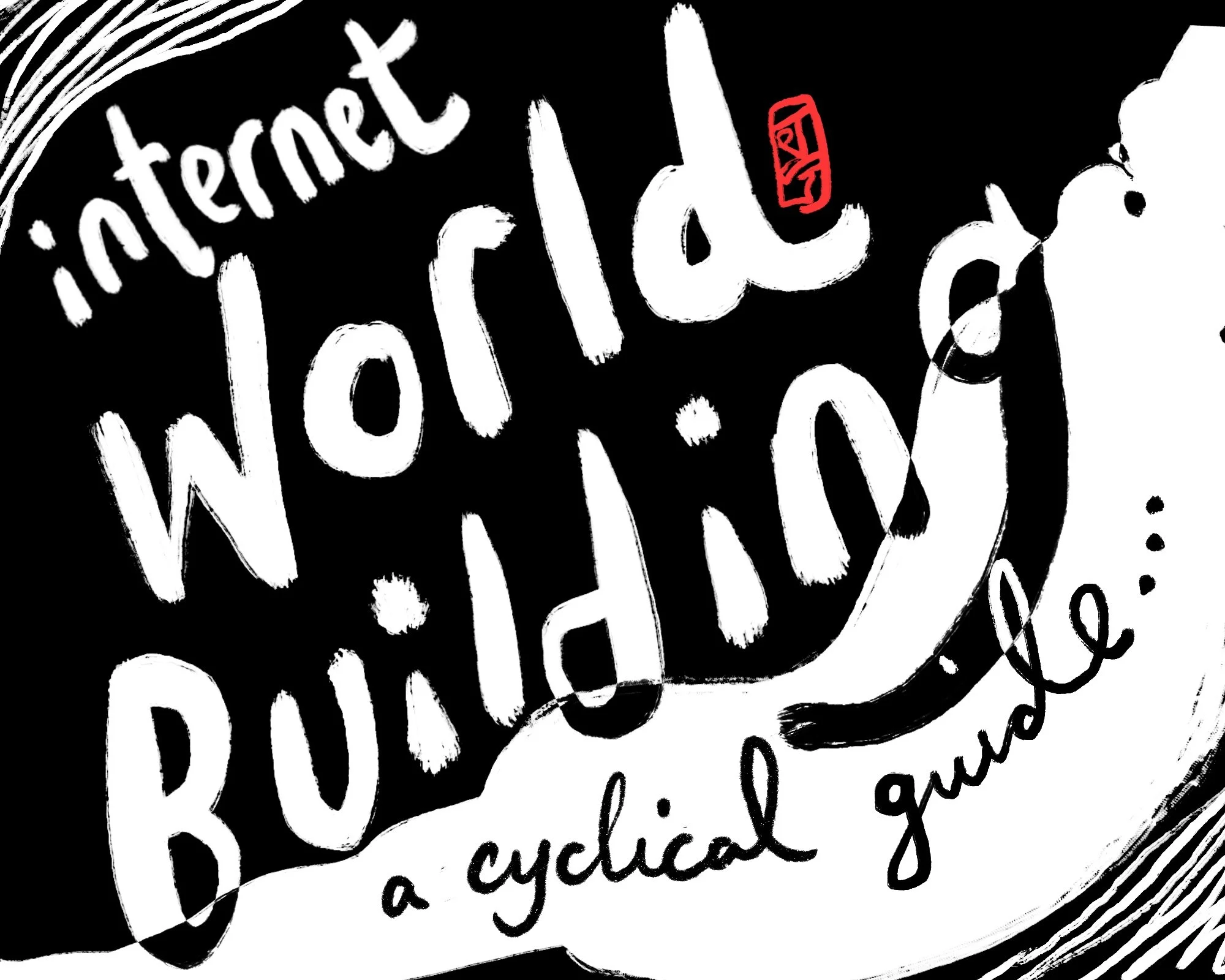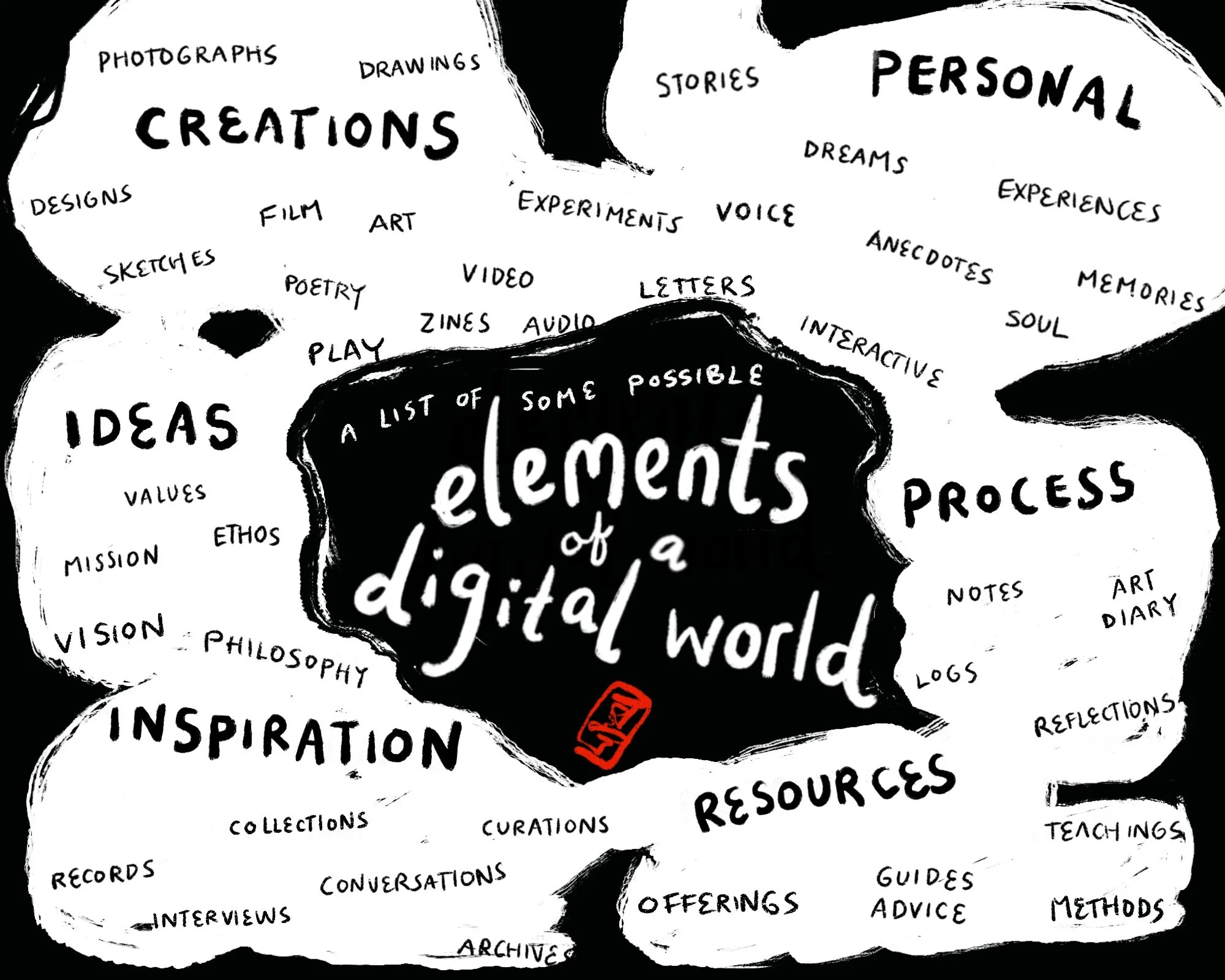how to build a world: a cyclical guide
this is part of an ongoing series about world-building. I write a weekly newsletter on world-building and the creative practice called guide.notes.
now that I’ve gone into all the rabbit holes of what a digital world is, its infinite creative possibilities, who it’s best suited for, how it can make you holistically wealthy, and WHY build a digital world as a creative entrepreneur (instead of say, stressing out about content marketing)… this post is going to be a brief, cyclical guide on the how.
I’m keeping it brief, systemic, and big-picture in this post because I want to give a framework that you can apply to your work, no matter where you’re at in the process — whether you’re just starting out, or on your nth iteration. The nitty-gritty will come later.
Okay, here’s the process flow:
Step 1: Build a website.
(See: house on the webs)
Build a website. If I were to break this down further, I’d say that you can think of website-building in three steps and aspects to consider.
The Vessel — if you’re using a website builder, just click a few buttons and make some blank page(s), and drop some words and pictures into it. Done. No stress. Every hesitation here is just perfectionism and creative constipation getting in the way.
The Structure - think about how the individual parts of your work connect and relate with each other. Is there an overarching theme? Do you want it to have its own page? How do you want to organize it?
The Experience (and feeling) - what experience do you want to have with your website-world? How do you want people who visit it experience it? What is the feeling you want to convey? How can you create this feeling?
Website Builder Platforms: Without needing to learn how to code — an adventure in itself — there’s a number of website builder platforms you can explore. The one I’ve used and have recommended the most is Squarespace (where this site is currently built on) — for its balance of dead-simple accessibility & robust content features, but others I’ve explored (or am curious about exploring) include: Webflow (a bit on the technical side), ReadyMag, Cargo, Super.So (for Notion lovers). A very fun and experimental one I recently found recently is mmm.page.
When it comes to picking a platform, don’t let this be your bottleneck.
Unblock yourself, just do it: The process of birthing a new website from scratch can feel super intimidating, so if this is a bottleneck for you, (as in, if you’re procrastinating on this, putting it off, dreading getting started) I’d suggest you find ways to make this feel as frictionless as possible. As in: don’t obsess over a perfect design. Start with a template. Work iteratively and cyclically. You can (and should) make it magical and special later.
Also: I’d say that the hardest part is not the “building,” — but distilling your nebulous visions and dreams down into a clear, information structure — the map that is your world.
I teach an intensive course guiding you through an organic, intuitive process of website building — house on the webs — and have a number of visual guides (more forthcoming) on this process.
A website is not a one and done thing — it’s a living organism. A garden that you return to, again and again.
Step 2: Create something, everyday, and just hit publish.
Get into the habit of creating something on a regular (preferably daily) rhythm, not “once in a blue moon.”
Why a regular rhythm? Because we have way too much to worry about, think about, and manage on a day-to-day basis. The act of making something daily forces you to sit with and sense into what’s alive in you — this act of listening and pulling forth, in itself, a deeply essential practice to the creative life.
What should I create, and post? The point of a digital world is that it is an infinity garden with the capacity to hold anything and everything.
Your posts don’t have to be brilliant. They can be random doodles, half-formed thoughts, a single photograph you took on the way home, a note-to-self. The key is to keep your creative process in flow.
Here’s a map of possibilities for a digital world. Read more about this in detail in this post.
Step 3: Organize your work (let structure emerge organically)
I usually recommend that you create and collect a body of work before you think about how to organize it. Collect all the pieces before you make a collage out of it, and this will help you think about the relationships between forms, topics, and themes. Rather than making a filing cabinet, compartmentalizing your creations as different selves/forms — then creating FOR those folders, try to do the opposite. Start bottom up, instead of top down (the structure).
Why? Because before you can make a map of your world, or curate a delightful experience for your guests, you need to let the world be free to grow vines and tendrails. Let the garden grow with its own life. The pruning can happen later.
How to organize: when you are ready to organize, it means you’re able to take a step back from your body of work, and look at the threads and veins that run underneath it, connecting it to each other.
Here’s a simple way to do it.
As you publish new posts, organize your creations by using categories + tags. Most website builder platforms with CMS systems will have this.
If you’re planning to share a wide variety of multi-form work, categories could be FORMS, and the tags could be TOPICS. Or, they can both be thematic.
If you’re feeling stuck about structuring, you can start by making a mind map on pen & paper, or I also like Figma and Obisidan for this.
Step 4: Find your rhythm, and repeat
The thing I most want to impress on you is that world-building is an iterative, ongoing process. Do it only if it nourishes your creative life and spirit, otherwise it’ll just weigh you down with guilt.
My personal rhythms:
Daily creation — I like to create and post daily, because for me, it’s easier than weekly. One idea sprouts other ideas, and then I find a momentum that carries me from one post to the next. On days when I don’t know what to write, I just sit there and draw until an idea comes out.
Weekly or monthly website evolution & organizing — okay, I’m super guilty of leaving my website and structure itself a total mess for months, if not entire years. this is like having a messy house (also guilty). I’m trying to be better about this — by creating weekly rituals of making small changes to evolve my website, or find ways to better organize its structure, and curate/design its experience. I keep an ongoing list of changes I’d like to make, and slowly deploy them, over the course of each week. This may not always happen in a linear way, but it does happen.
I’m not one to suggest that my rhythms should be your rhythms — what’s more important is for you to find a regular ritual of world-tending / planting / growing your website-world in a way that feels sustainable and nourishing to you.
Lastly, I’ll leave you with two things.
Your world will change, over time — this is a good thing. I reflected on the different phases of my journal in 2020: 5 years of keeping my journal (at the time, I didn’t have the framework of “world-building”). I read that post now and barely recognize anything in there.
If you need to take a break, take a break. Don’t be consistent if it feels like a drag. Step back, and let the world evolve with you, or let it hibernate. Whenever I come back from a long travel or hectic period of life, I’ll start by asking myself: what am I craving or curious about creating? What do I want to articulate, explore, expand on, and share?
At the end of the day, world-building is a creative practice — a way of inhabiting the internet as a creative practice. rather than consuming and performing, world-building is the practice of being, existing — through what we create. this means that like all creative practices, it requires living attuned to the seasons of your psyche, and knowing when to ride the momentum, when to unstuck yourself, and when to rest.
I write a weekly newsletter on world-building and the creative practice called guide.notes.
see also:
6 visions for a digital world
house on the webs school
a moody creative’s guide to work overwhelm
declogging your creative work flow



